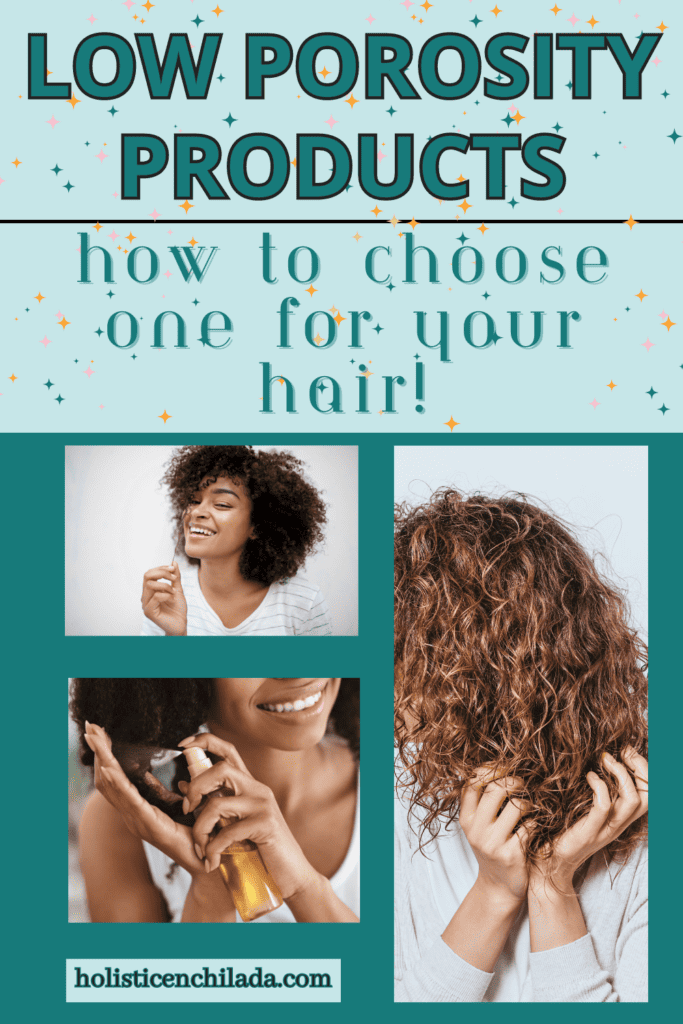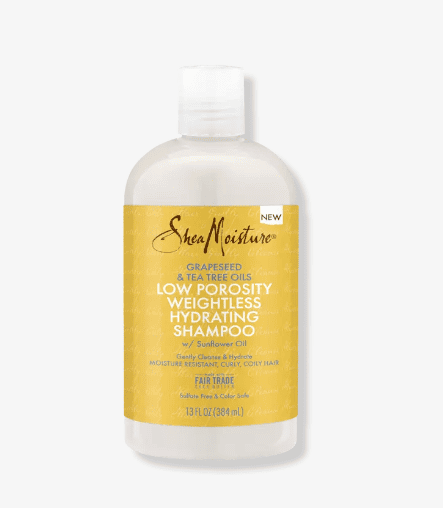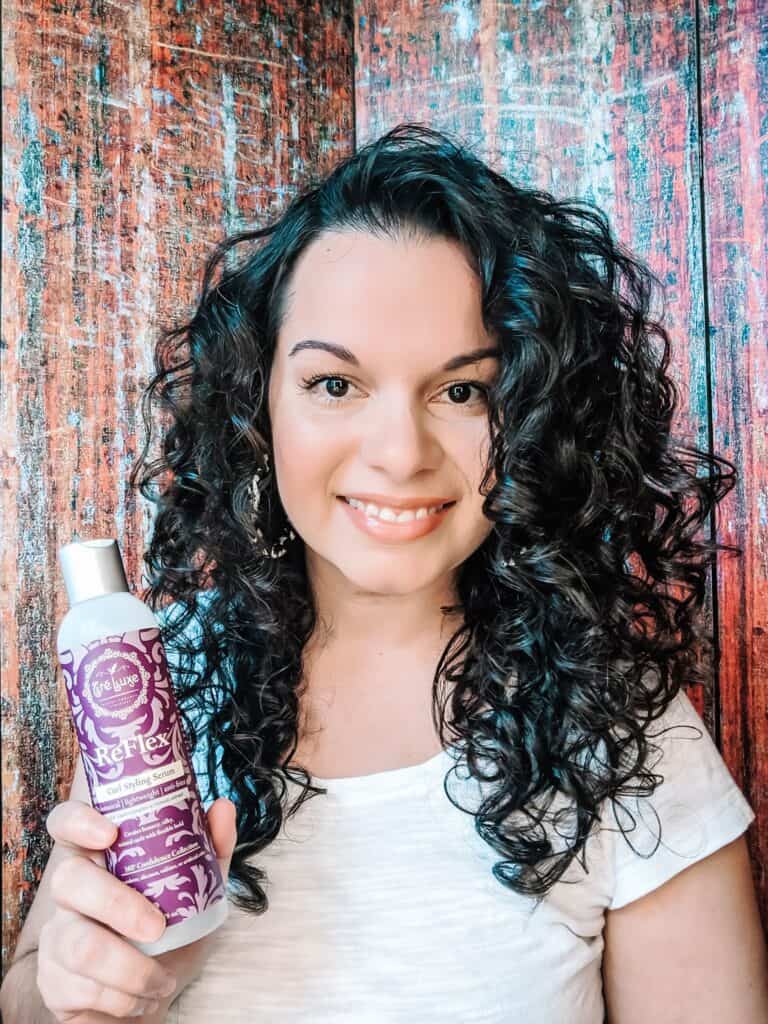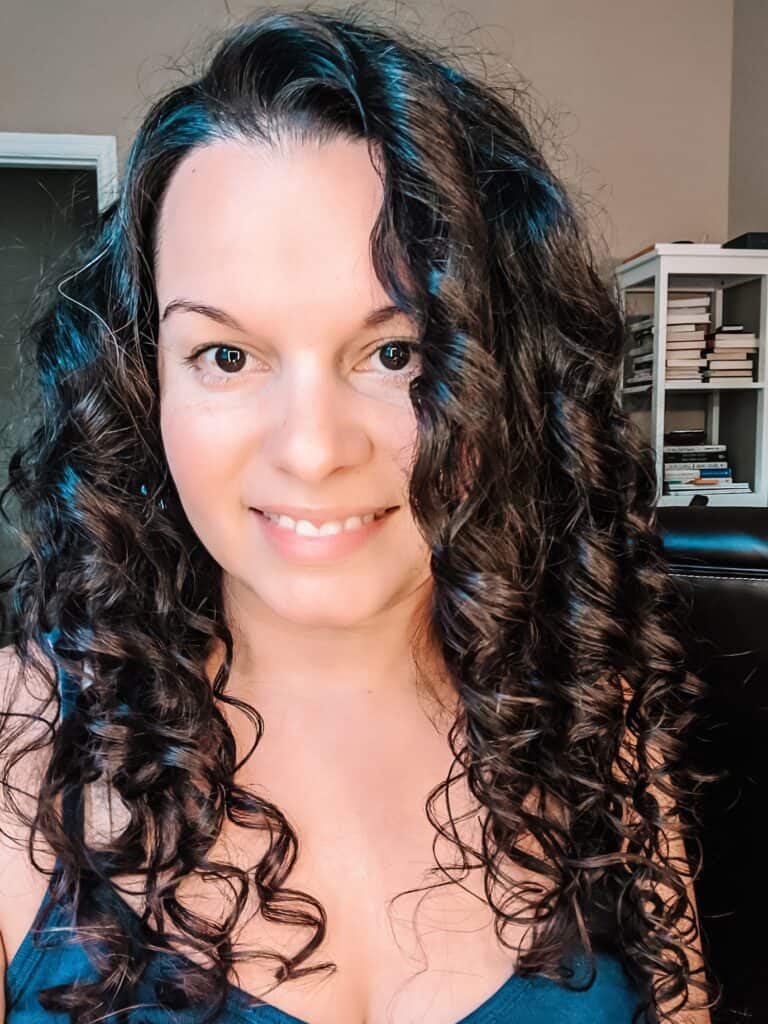Low Porosity Hair Products – How to Choose One for Your Hair!
This post may contain affiliate links, and I will earn a commission if you purchase through these links. Please read the disclosure policy for more details.
If you feel unsure how to choose low porosity hair products, don’t worry – you’re not alone. Lots of people aren’t sure how to care for low porosity hair and might not even know how to identify their porosity.
Most people tend to focus on their hair type at the start of their natural hair journey. Knowing your curl pattern is essential, and you can check that with our curl type quiz. But when you’re planning your curly hair routine, porosity is just as important.
In fact, understanding your hair porosity is vital for natural hair types. That’s because the curls, coils, and spirals in natural hair stop your scalp’s natural oils from traveling down your stands, which can make them dry. It can be hard to hydrate low porosity hair, so you need to take extra care to moisturize your low porosity curls.
So let’s take a deep dive into what causes low porosity, how to identify it, and some of the best products for low porosity hair. You’ll also discover some handy tips that will make caring for your tresses simple.
What Is Low Porosity Hair?
Porosity refers to how easily your hair absorbs and loses water or moisture. It’s usually described as one of three porosity levels: low, medium, and high porosity.
If you have low porosity hair, your hair strands are covered in tightly packed, overlapping cuticles that lie flat against the shaft. This protective barrier makes it difficult for water, oils, and conditioners to penetrate into the strand’s center, which can lead to problems like dryness, tangles, split ends, and breakage. It’s also why low porosity hair is usually extremely smooth.
It’s helpful to remember that no type of porosity is better than any of the others. But it’s another piece of information that will help you learn how to manage your hair and keep it looking its best.

Causes of Low Porosity
Although factors like chemical processing, heat damage, and environmental factors can influence your hair porosity, they are more likely to cause high porosity by damaging and opening up the cuticle layer. This allows hydration into the strands easily but affects your hair’s ability to retain moisture.
Low porosity is usually due to genetic factors, and there’s not much you can do to treat low porosity hair. So it’s better to work out the right products and hair care routine for your mane, so that you can make it look as good as possible.
Identifying Low Porosity Hair
Knowing some of the most common low porosity hair characteristics can help determine whether your hair has low porosity.
Does this sound like your hair?
- Hair products sit on the outside of the shaft instead of being absorbed
- Your strands take a long time to soak through when you go in the shower or swimming pool
- Protein-rich deep treatments leave your hair feeling stiff and brittle
- Your hair strands feel rough, coarse, or wiry
Testing Your Hair
So how do you tell if you have low porosity? Luckily there are two quick and easy ways to check your porosity at home.
Although it’s not 100% accurate, the water test (or float test) is a quick way to determine porosity. First, wash your hair to remove any product build-up or dirt, and dry it without adding any styling products. Once it’s dry, take a few strands and drop them into a glass of water.
If the strands float at the top of the water, this probably means they have low porosity. If the strands sink to the bottom of the glass, they probably have high porosity, and if they float in the middle, you probably have medium porosity hair.
Bear in mind that if you have long hair, your hair may have low porosity at the roots and higher porosity towards the ends. It could be worth cutting your strands in half and testing the roots and ends separately.
You can also check the porosity of your hair through careful observation. Low porosity hair tends to be smoother and shinier, thanks to the flatter cuticle. If you find that oils and conditioners sit on your strands instead of being absorbed, and if you’ve never dyed your hair or used excessive heat, you probably have low or normal porosity.
You will probably also find that your hair takes a long time to get soaked through when you go in the shower or swimming pool.
But if your hair easily absorbs oil and conditioner, and your locks soak through very quickly in the shower or pool, you probably have high porosity hair. You might also find that your strands don’t look very shiny and might even feel bumpy due to the raised cuticles.
Treating Low Porosity Hair
One of the most crucial things you can do for low porosity hair is provide it with plenty of hydration. You may have to work a little to get your hair to absorb moisture, but there are several ways to achieve good hair health.

Wash Days
On wash days, reach for a sulfate-free shampoo to avoid drying out your low porosity locks. It’s also a good idea to use a clarifying shampoo once or twice a month to remove any product build-up. This will give your strands the best possible chance of absorbing the conditioning treatments that follow.
Avoid heavy protein-based products that will weigh down your locks and cause product build-up. Lightweight formulas containing hydrating ingredients like argan oil, vitamin E oil, or grapeseed oil are better for low porosity locks.
Steaming your hair for 15-20 minutes before washing can open up your cuticles, which helps to deliver much needed hydration deep into your strand. If you don’t have a hair steamer, try sitting in your bathroom with a hot shower running to fill the room with steam.
Between Washes
Between washes, use lightweight, water-based products to keep your locks hydrated.
If water appears at the top of your product’s ingredient list, it’s probably 50-90% water. These will be absorbed better than oil- or silicone-based products, which are more likely to build up on the outside of the hair.
If you want to use oils or silicones, opt for lightweight products to avoid weighing down your locks.
LCO vs. LOC Methods
As well as picking the best products for your natural hair, you can also get more from your products by using the LCO method.
This variation of the LOC method involves drenching your hair in liquid or leave-in conditioner, then applying cream over the top of that, and finally sealing in all that gorgeous moisture with hair oil.
Layering your products like this can really help your low porosity strands absorb more moisture.

Picking the Right Products
Some of the best products for your locks include:
- Alkaline Shampoos: Clarifying and exfoliating shampoos open up your hair’s cuticle, which can help to get more moisture into your strands.
- Oils: Olive oil, coconut oil, and jojoba oil hydrate your hair and help to seal in moisture
- Butter: Shea butter and mango butter will moisturize your hair without weighing it down
- Leave-in Conditioners: A good leave-in conditioner will hydrate your hair and make it more manageable
- Deep Conditioner: Regular deep conditioner treatments are essential as low porosity hair tends to be dry
Ingredients to Use With Low Porosity Hair
These ingredients are suitable for your locks:
- Behentrimonium methosulfate – read more in our guide to Behentrimonium methosulfate
- Hair-friendly alcohols like Cetyl alcohol or Stearyl alcohol
- Humectants – read more in our guide to humectants for hair
- Good oils and butters such as Avocado oil and Shea butter – remember, not all of these will suit everyone
- Natural ingredients like aloe vera gel, flaxseed gel, marshmallow root, and slippery elm
- Cetrimonium chloride
- Some proteins like keratin, collagen, and hydrolyzed silk
Ingredients to Avoid With Low Porosity Hair
It’s best to avoid these ingredients:
- Strong sulfates like sodium lauryl sulfate or ammonium laureth sulfate
- Heavy silicones – these should be avoided or used sparingly as they can cause build-up
- Propylene glycol
- Drying Alcohols – these will dry your locks
- Some polyquaternium ingredients – these build up
- Some large proteins (which should be used with caution because they can build up easily)
- Heavy ingredients like lanolin or petrolatum that will build up on your hair strands
The Best Low Porosity Hair Products
There’s a wide range of products for low porosity natural hair on the market, and this is not a complete list. However, it will give you a good starting point and some ideas of products you can try.
Choosing the right products will also depend on other factors like your hair type and density. So take time to try different products and hair routines; when you’ve found what works for your hair’s porosity, looking after your locks will become much easier.
Shampoos
Find a longer list of the best shampoos for low porosity hair here.
SheaMoisture Low Porosity Protein-Free Shampoo
Briogeo Scalp Revival Micro-Exfoliating Shampoo
Bounce Curl Gentle Clarifying Shampoo
Bumble and Bumble Hairdresser’s Invisible Oil Shampoo
Kinky Curly Come Clean
Conditioners
SheaMoisture Low Porosity Protein-Free Conditioner
Maui Moisture Nourish & Moisture + Coconut Milk Conditioner
Giovanni 50:50 Balancing Conditioner
Alikay Naturals Caribbean Coconut Milk Conditioner
Jessicurl Too Shea Extra-Moisturizing Conditioner
Other
Briogeo Rosarco Oil
Camille Rose Curl Love Moisture Milk
TWIST Boss Bounce Light as Aire Buildable Styling Cream
BondiBoost Rapid Repair Serum
LUS | Love Ur Curls Irish Sea Moss Gel
Use code HOLISTICENCHILADA10 to save at LUSbrands.com
Low Porosity Curly Hair Products and Treatment – Tips and Tricks
Once you’ve identified that you have low porosity hair, these simple hair care tips will help you to keep it in the best possible health.
Cleanse your hair with products for low porosity hair
Ensure you use a nourishing shampoo for low porosity hair, and avoid sulfates, as these can dry your locks even further.
Focus on moisturization
Low porosity hair struggles to absorb hydration, so use products that will help to keep added moisture locked into your strands.
Humectants like collagen, keratin, and hyaluronic acid help to attract moisture and lock it into your strands, so look out for these ingredients in shampoos, conditioners, and deep conditioning treatments.
Avoid heavy formulations
You might think you need to use deep conditioners with rich creams and butters to battle dryness. But your hair can’t absorb these heavy products, so layering on lighter products can give better hydration.
Embrace steam treatments
As well as using warm water to open the hair cuticle, you can also use a hair steamer to help your conditioning treatments penetrate deep into the hair shaft. If you don’t have a steamer, try running a hot shower to steam up your bathroom.
Section hair before applying products
Simply slathering the product over your entire head won’t give you maximum benefit. Take the time to section your hair first to ensure every strand gets coated in your product or conditioner. Applying conditioner with warm water will help to improve absorption by opening up the cuticle.
Clarify regularly
Low porosity hair struggles to absorb moisture, but product build-up on your strands will worsen the problem. So use a clarifying shampoo once or twice a month to deep clean your locks and make it easier for your conditioning treatments to do their job.
Schedule regular trims
Low porosity tends to cause dry and brittle hair, so split ends and breakages can be a common problem. Regular trims every 6-8 weeks will help to avoid them and keep your hair looking healthy.
Products for Low Porosity Hair FAQs
Looking for more information on products for low porosity hair? The answers to these frequently asked questions may help!
Is Low Porosity Hair Healthy?
Low porosity hair isn’t necessarily healthier than higher-porosity hair, both can have good and bad qualities. But it has tightly closed cuticles that make it look healthier and shinier than high-porosity hair.
Stresses such as heat or chemical treatments often result in high porosity strands, so having low porosity hair probably means you haven’t subjected your locks to this type of hair damage.
How Often Should Low Porosity Hair Be Washed?
How often you need to wash low porosity hair will depend on many factors. These include your hair type, how much oil your scalp produces, the products you use, and your lifestyle.
However, low porosity hair generally requires extra hydration, so it’s best to avoid leaving it too long between wash days.
What Hair Type Is Considered Low Porosity?
Low porosity hair can be straight, wavy, or curly and there’s no firm link between hair porosity and any natural hair types.
Should You Use Rice Water on Low Porosity Hair?
There’s no clear answer to this question. Some people find that rice water works well, but others find that protein builds up on the outside of the hair strands, which may cause damage.
If you want to use rice water in your hair care routine, it’s best to test it first on an underneath section of your hair to avoid any damage.
How Fast Does Low Porosity Hair Grow?
There’s no particular evidence that low porosity hair grows faster or slower than high or normal porosity hair. However, it tends to be dry and brittle, and breaks easily, so it’s essential to nourish and moisturize your tresses regularly to help with length retention.

Low Porosity Hair Products – The Bottom Line
When all you want is a soft, shiny mane of hair, caring for low porosity hair can feel like a challenge. But low porosity isn’t necessarily bad; in fact, it can be a sign that you haven’t subjected your hair to damaging chemicals or heat treatment.
There isn’t much you can do to change your hair’s porosity, but you can carefully alter your natural hair care routine to work in your hair’s favor. There aren’t any strict rules you need to follow; just use your judgment to choose lightweight products that contain ingredients that suit low porosity hair.
By understanding your hair’s needs, choosing the right products, and following some simple hair care tips, you will soon discover how to care for your low porosity curls and keep them looking gorgeous.























